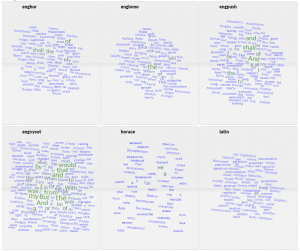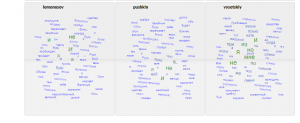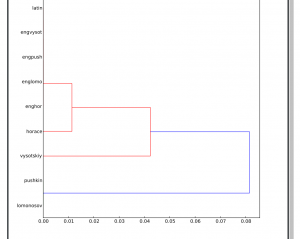During these past weeks we learned a lot of new platforms that we can use for our own text analysis. Using different platforms you discover new ways of reading and analyzing your corpora. As Dr. Diane Jakacki was telling at class “Imagine you are an eagle, and from the height of your flight you see down in the prairie a little mouse” about distant and close reading.
Stylometry and Lexos
Stylometry helps you to explore patterns in texts, stylistic analysis. On macro-level (when we are eagle and looking down from the very high) Lexos and it’s dendrograms are very useful. First of all, Lexos helps you with cleaning your text and editing your stop-list words. For me it was a big surprise that multiword cloud can read Russian.


As I have small texts, for me it wasn’t a problem with the stop-list words or cleaning the text, main words like “I”, “monument”, “alive”, “die” are still appearing so I din’t change there anything. But still the results of this word cloud are different from the one I got in Voyant, which means that different platforms also read “differently” the same texts( the only option that doesn’t ignore Russian).
Then I decided to see how does dendrograms work.

I got the results that I expected: 1. it ignored Russian; 2. Lomonosov’s and Horace’s works were similar, that’s how it should be, because Lomonosov was translating Horace to Russian, including the poem Monument. However, the unexpected results were: 1. style of Vysotsky (who lived in USSR at 70s-80s) was also close to Lomosov (who lived in Russian Empire at XVIII century), which I can hardly believe and which I’m going to double check. My guess for noe is that probably the program caught the MFW in those two poems as “Muse” and other old Greek names and words ; 2. Pushkin (who lived in XIX century) was also close to Vysotsky style and that’s at least understandable because both poems were about building a monument to themselves through their works and that both poets were writing against the present system in the country. for me, that’s amazing that machine could see these details that I didn’t pay attention before. This reminded me skype-talk with Dr. O’Sullivan when we were talking about certain authors styles and how we can compare them. Of course, the most part the comparative analysis still will do the researcher not machine, using the advantages of close reading (when you can see a little mouse in the prairie).
TEI – oXygen
You can get more sophisticated about how you want to look at your text in the browser – and why you want others to look at certain things, too. As Pierazzo mentions in her work that marking up the text is an “interactive act”, I would add to that it could be “a complete disaster” or “making love with your text”.
Using this tool we need to know which parts of text we want to focus on. Here we can come back to Pierazzo and what she thinks about that “Which features of the primary source are we to reproduce in order to be sure that we are following ‘best practice’?” Marking up the text is very convenient, you are deciding at how many topics you want o focus in your text, for instance, only names and places.Then you mark up all particular words that are related for names and places. But here is the trick: working with poems I can’t say that this is only “black or white”. Marking up the text is your own personal way of seeing it. In my corpora I differentiate several topics: life, death, monument, glory, time, nation, sound, etc. Each author talks about it differently and brings up new metaphors for that and I need to rely only on my “feeling” of the text and my background knowledge. After we worked at class on Keat’s poem I decided to mark up my texts, but I wasn’t very successful with that 🙁
My final thoughts about the work we’ve done these past two weeks were “Is the reader dead?” Just as Bathes “Death of the Author” we are now experiencing “death of the reader”. Although, working closely with tools I realized that reader is not dead, he’s very active, he “interacts” with machine and produce a new text that gives us many answers or leaves us with many questions.
One reply on “Is the reader dead?!”
Very nice! Well done!